The Alaskan Malamute is a dog breed originating from Alaska. Initially, this breed was bred to pull dog sleds and transport goods on snow. Now, the Alaskan Malamute is a common household pet with a wide variety of colors.
When most people think of Alaskan Malamutes, they often picture a giant wolf with gray and white fur. However, these big dogs can come in a wide variety of coat colors that are much different from the standard. Some of these coats, like snow, can range from black to red to even white.
Below, we will look at the acceptable breed coat colors according to the American Kennel Club (AKC). In addition, we will also be checking out coat colors that aren’t accepted as “official” due to being a genetic defect. So, let’s look at Alaskan Malamute colors from rarest to most common.
Alaskan Malamute Coat Color Terminology
Before we go over the rarest coat colors, we need to take a look at some terminology:
- Undercoat – the fur that grows the closest to the dog’s skin.
- Guard hairs – the outermost layer of fur.
- Allele – is a specific copy of a gene found on a DNA sequence that influences coat traits and colors.
- Recessive – a gene that a dominant gene can mask.
- Dominant – a gene that expresses itself stronger than others.
- Eumelanin – black pigmentation responsible for coloring a dog’s coat.
- Phaeomelanin – red, yellow, white, and other pigmentation responsible for coloring a dog’s coat.
- Banding and tipping – when hairs have bands or tips of more than one color.
- Cap – dark pattern of hair on the head of the dog.
- Stripes – also known as brindle, is a coat pattern in dog breeds that produces fur with “tiger” stripes.
#1: Black Alaskan Malamute – Extremely Rare
In contrast to the all-white coat type, there is also a full black. The black coat is also rare, as it has full black coloring in the undercoat and guard hairs. While the coat type is possible, it typically doesn’t happen with Alaskan Malamutes.
A recessive black allele is what’s responsible for producing this coat color. However, it’s improbable to create a black Alaskan Malamute. This is because even recessive black dogs generally won’t produce offspring with solid black coats.
#2: Lilac – Rare
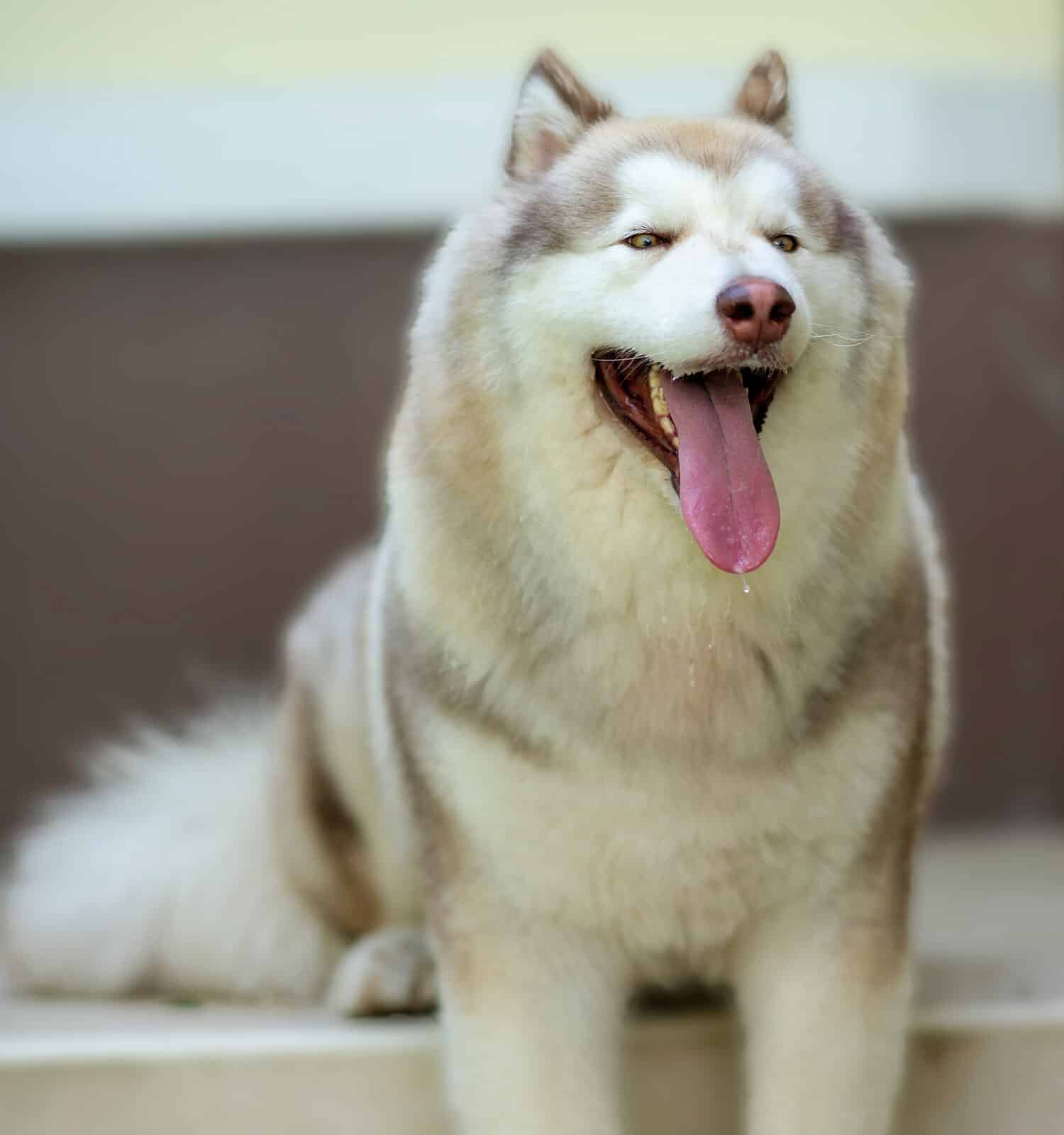
Lilac Alaskan Malamutes almost look like they have a slight purple or pink tone to their fur.
©LeeSensei/Shutterstock.com
Lilac coloring is also a very rare coat color for Alaskan Malamutes. The coat coloring happens when you cross a dog with brown and diluted black eumelanin. What happens is the coat will end up looking beige or taupe coloring. This produces a diluted brown pigment that appears lilac.
A lilac-colored Malamute will also have distinctive features such as a light grey shade of brown lip, nose, eye rim, and skin. The lilac coat type also can look different, as it can be produced with a handful of coat patterns. Depending on the coat pattern, it can look completely different. A lilac Malamute will have yellow to yellow-green eyes.
#3: Blue and White – Rare
A “blue” and white Malamute isn’t blue but has a particular hue. They are very similar to the grey and white huskies but tend to look slightly different. However, breeding this type of coat color is rare.
The blue is a diluted black eumelanin and causes the pup to look slate gray. Their coat tends to have blue hair tipping or banding, with gray features. This can include gray skin pigmentation around the eye, lips, and nose.
Eyes tend to be a yellow-green or hazel color with a gray nose. This coat type is the only kind of Malamute that can’t produce a black nose due to the inability to produce black pigment. Hence, they aren’t considered an official color.
#4: All White – Rare
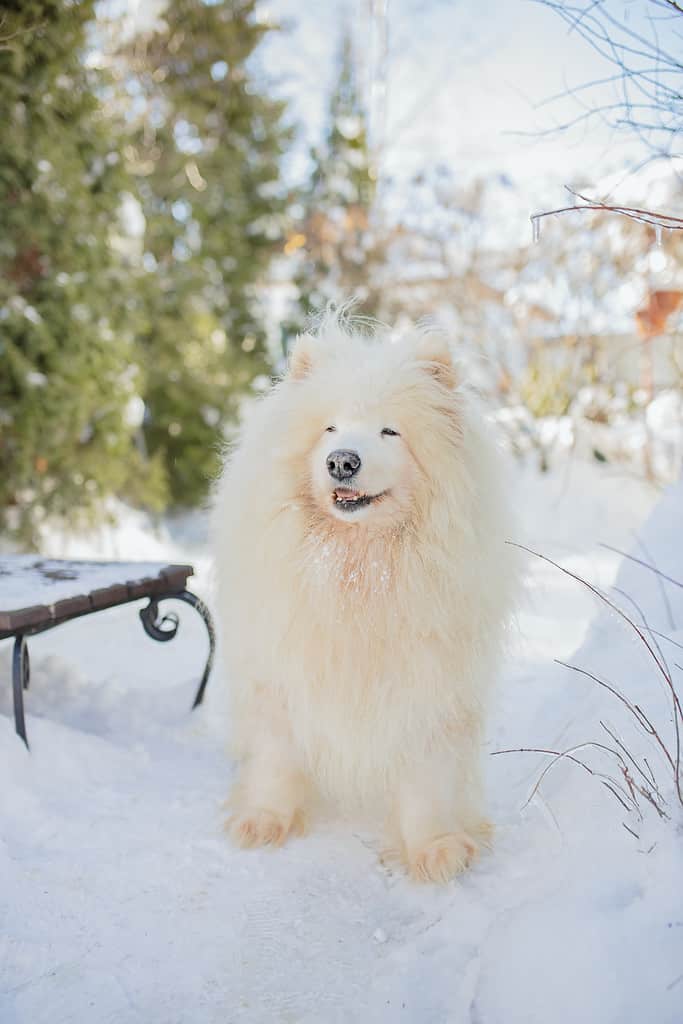
White Alaskan Malamutes can be pure white or have cream coloring.
©ksenija18kz/iStock via Getty Images
The all-white coat coloring of an Alaskan Malamute is rare and often takes the look of a Samoyed. The dog must be born without black shading, which helps produce that stunning white or cream-colored coat.
What’s responsible for this coloring is a recessive red and white phaeomelanin intensity that stops the coat from producing eumelanin and changing to a darker color. In simpler terms, the coat color has been selectively chosen through the breeding process to have recessive genes.
What classifies an Alaskan Malamute as being all white is a solid white undercoat, guard hairs, undercoat, ear lacing, cap, and stripes on its back. However, they can have shades of cream, pale yellow coloring, or tints of red. Another distinction is a black nose that fades to pink.
#5: Silver and White – Rare

Silver and white coat types are similar to grey but have a lighter undercoat with silver-tipped guard hairs.
©Hanna Borysenko/Shutterstock.com
The silver and white coat color is rare but breedable. It’s used to describe coat types that appear gray in certain areas. However, many confuse this as the agouti domino, but it’s different from a genetic standpoint. The “true” silver and white coat type is made with the shaded sable pattern.
A silver and white coat type has specific features. This includes the shaded sable allele that makes the guard tips silver instead of gray. This is a rare coat color because silver and white coat types can produce puppies with different colors.
Distinctive coloring includes light gray guard hairs and a white undercoat. There must be a lack of black tipping on the guard hairs. As mentioned previously, the proper type of silver and white will have a shaded sable coat pattern.
#6: Red and White – Rare
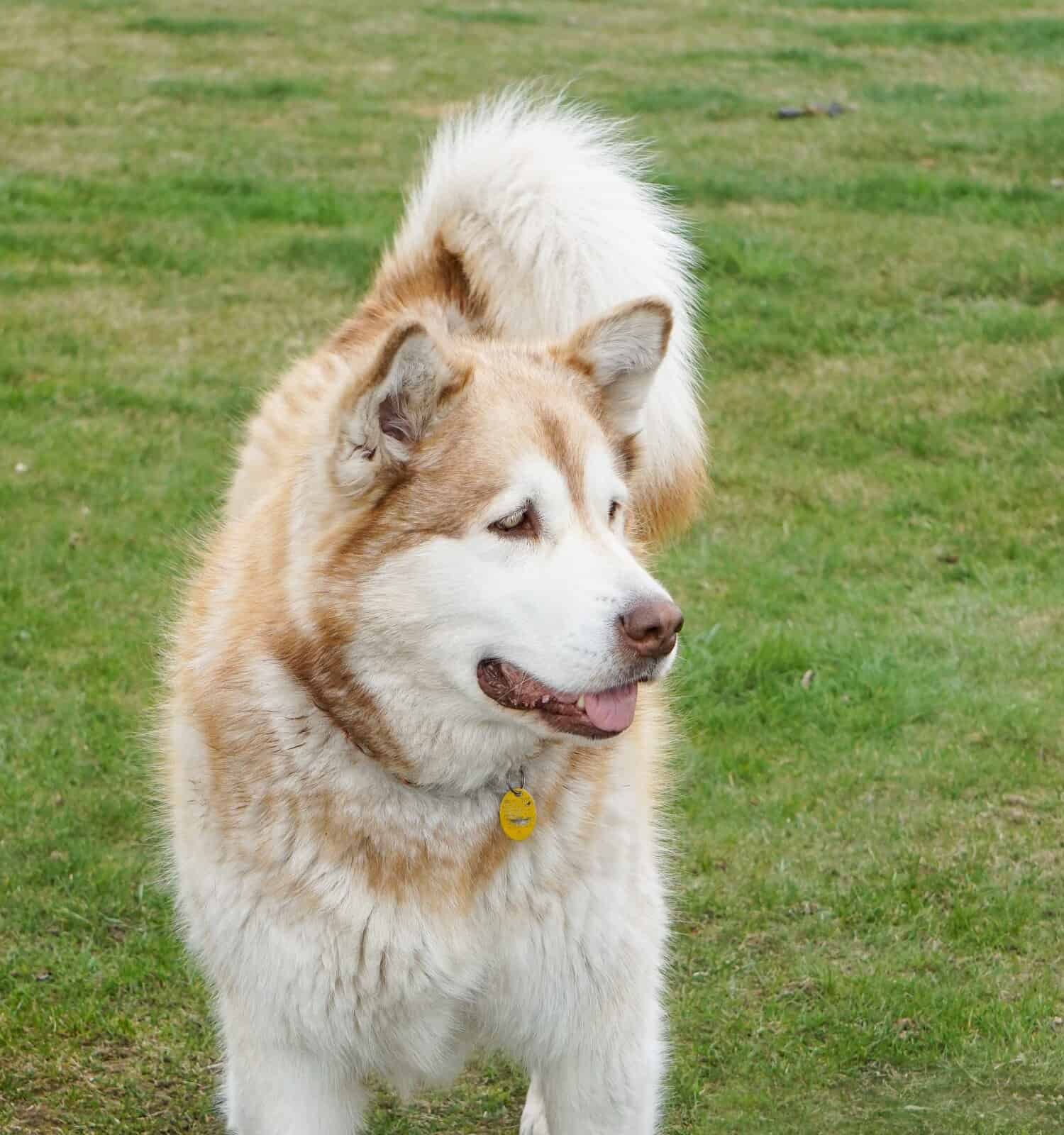
Alaskan Malamutes with red and white coats can have a wide variety of different tones depending on the parents.
©Alicja Graczyk/Shutterstock.com
The red and white coat type is rare but more commonly seen amongst Alaskan Malamutes. The reddish hue of these dogs can vary greatly, but they all tend to have a white or cream undercoat with a reddish top. The red coloring hues range from orange, brown, and red to mahogany.
What’s responsible for this is the brown eumelanin, which is a distinctive chocolate or liver coloring. The coloring also has red phaeomelanin, which produces that stunning red color.
An Alaskan Malamute can only have this type of coat coloring if it lacks any black pigmentation. All black pigment will have turned to brown. This includes a brown nose, eye rims, and lips. The dogs also commonly have yellow or amber-colored eyes.
#7: Black and White – Common

An Alaskan Malamute with black and white coloring has distinctive features such as white “eyebrows.”
©asadykov/iStock via Getty Images
The black and white Alaskan Malamute is a more common coat color. It’s noticeable by its black-and-white appearance, mainly with a white undercoat. These dogs would resemble the white and black Shiba Inu if not for their size.
However, the main distinction in color is a ta point pattern but no northern domino allele. This produces a distinctive dark coat. The pale phaeomelanin creates the black fur with a tan pattern.
Distinctive features of the black and white Alaskan Malamute include black masking, solid black eye markings, and a black nose bar. On other coat types, these features are often lacking. In addition, the black and white coat type has black guard hairs on the back and a black or dark gray undercoat.
#8: Seal and White – Common
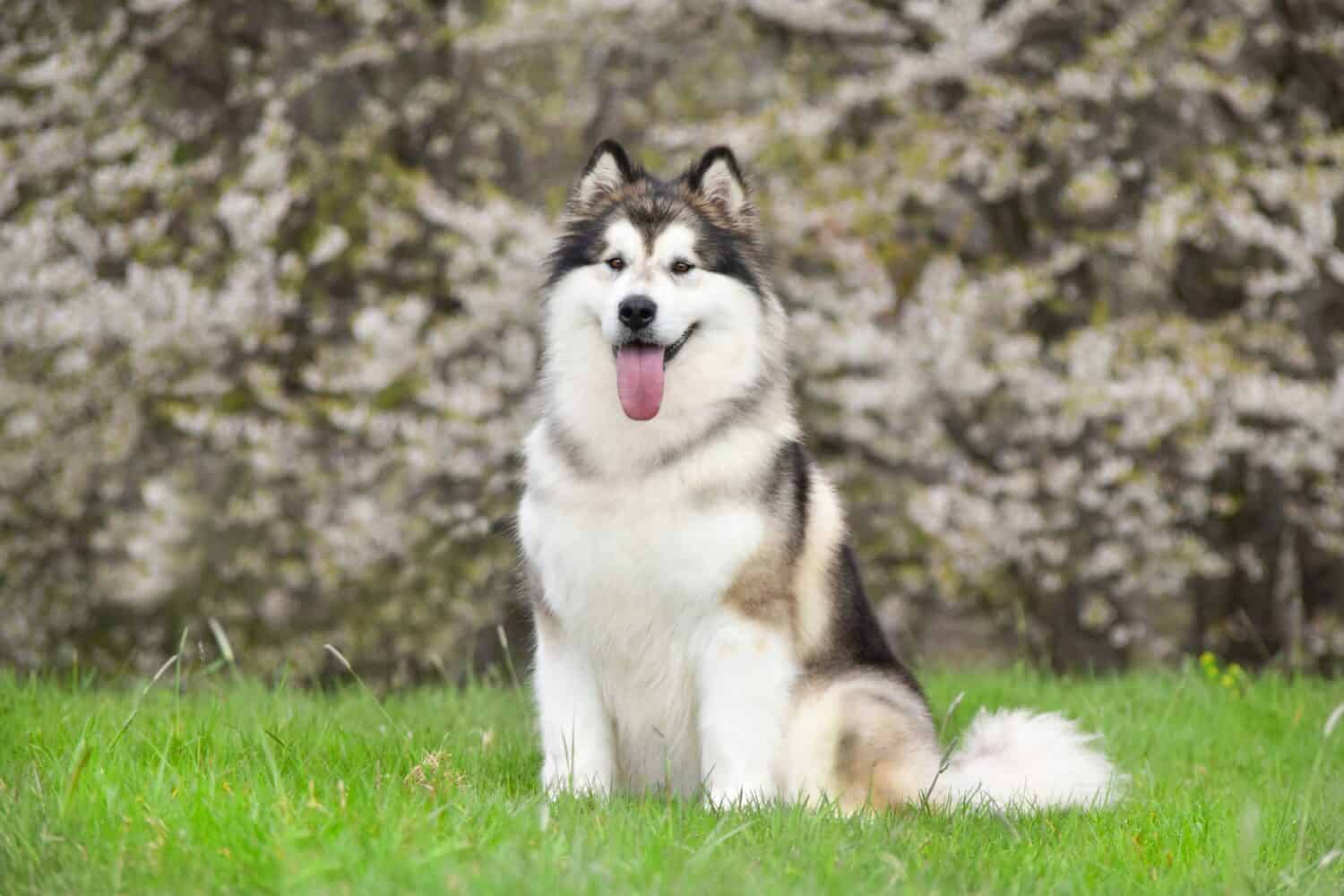
Seal and white are similar to black and white, except they have notable coloring around the body and a lack of a black mask on its head.
©Hanna Borysenko/Shutterstock.com
The seal and white coat type is exceptionally similar to the black and white but has genetic differences. Instead of having black eyebrows, it will have white eyebrows instead. In addition, it also lacks the black masking pattern.
Genetically, the seal and white coat type will combine black-based and black and tan patterns. The main difference is that the pattern changes due to the northern domino, which alters the amount of eumelanin produced by the coat. Instead, phaeomelanin becomes higher and results in the black and tan pattern.
Distinctive features include black-topped guard hairs with silver hair banding and a white or cream undercoat. Other features include a lighter color than black and don’t have a black masking pattern.
#9: Sable and White – Common

Sable dogs can have a multitude of colors, but yellow, orange, and red are particularly common.
©ceppy tri/Shutterstock.com
The sable and white coat colors are more commonly seen and often sought after. Their fur has a classic gray or seal pattern, which is spread out. They also have black banded hairs with different colors spread throughout. These colors can include yellow, orange, and red undercoats around the striped coats.
A closer look at sable coat genetics shows that they have strong phaeomelanin, which provides an intense color. While sable is a coat pattern, the coloring can vary greatly depending on the parent dogs. For example, a sable can be a gray and white dog with red phaeomelanin. On the other hand, a seal and white dog with red markings is still a sable.
#10: Agouti and White – Common

On the right is a baby Alaskan Malamute with an Agouti coat color. These often resemble wolves when they are fully grown.
©Yuriy Koronovskiy/Shutterstock.com
The Agouti and white are one of the rarest coat colors for Alaskan Malamutes. The coat color is a muddy shade with a black mask on it. Mainly confused with gray and white coats due to the dark shade, they have some distinctive features. This can include a sooty face, tiny cream-colored eyebrows, and intense banded colors with a full mask face. As the coat type ages, the muddy shade will change, which makes them harder to distinguish.
Genetically, these dogs have many traits that influence their coloring. They generally have a wild-type pattern with banded hairs on the back, nose bars, and goggles. In addition, they have a dark to moderate agouti pattern, which can be deep or light. One significant distinction is that the agouti pattern can have both tan point carriers and recessive black carriers.
#11: Grey and White – Common
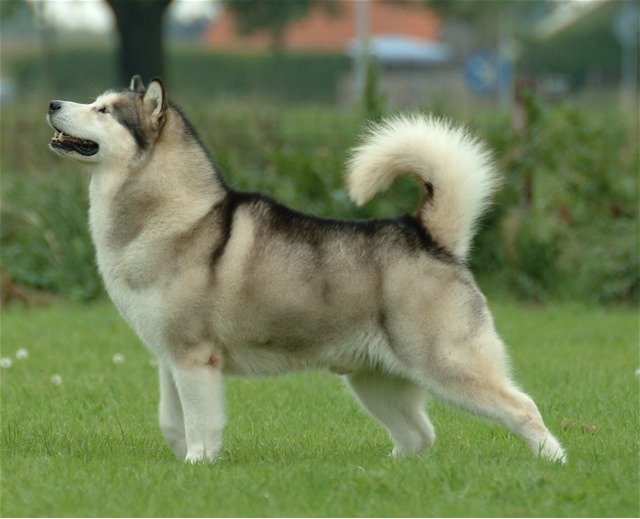
The most common is the classic grey and white Alaskan Malamute, which is notorious for resembling a husky or a wolf.
©SCMW, CC BY 3.0, via Wikimedia Commons – License
The grey and white coat color is one of the most common. This coat color is very similar to your classic grey wolf or husky. It’s identifiable by the grey and white mixture of hair, with black markings in certain areas.
What’s responsible for this is the black-based agouti pattern with an added northern domino. The coat has reduced eumelanin and more phaeomelanin, which causes certain areas to become grey. Distinctive features include white eye pips, pale face markings, and possibly a pink stripe down the nose.
In addition, there might be extended phaeomelanin banding at the base and less eumelanin banding along the top. The most notable features include the gray guard hairs with heavy black-banded or solid black hairs on the topline. Depending on the parents, the undercoat is generally grey, white, or cream.
Summary of Alaskan Malamute Colors: Rarest to Most Common
| Rank | Alaskan Malamute Color |
|---|---|
| 1 | Black |
| 2 | Lilac |
| 3 | Blue and White |
| 4 | All White |
| 5 | Silver and White |
| 6 | Red and White |
| 7 | Black and White |
| 8 | Seal and White |
| 9 | Sable and White |
| 10 | Agouti and White |
| 11 | Grey and White |
The photo featured at the top of this post is © Aneta Jungerova/Shutterstock.com
Ready to discover the top 10 cutest dog breeds in the entire world?
How about the fastest dogs, the largest dogs and those that are -- quite frankly -- just the kindest dogs on the planet? Each day, AZ Animals sends out lists just like this to our thousands of email subscribers. And the best part? It's FREE. Join today by entering your email below.
Thank you for reading! Have some feedback for us? Contact the AZ Animals editorial team.






